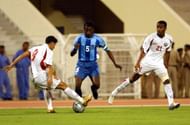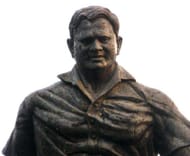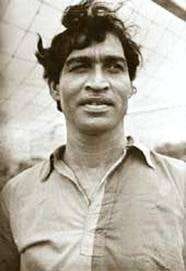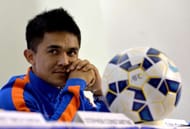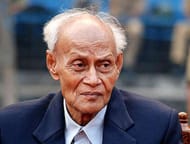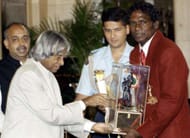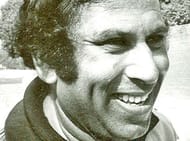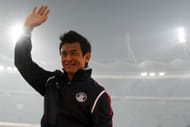Football has always taken a backseat in India in front of cricket, thanks to the immense popularity of the latter which is fueled by the success the Indian cricket team has had on the international scene. But football in India is slowly coming into the conscience of an average sports fan after a spell in the wilderness, with the new Indian Super League and the success of I-League clubs like Bengaluru FC in Asian tournaments.
It was not always like this. Indian football had a golden period in the 50s and early 60s when the national team was often considered one of the best teams in Asia. Not to mention the commendable achievement of the team to qualify for the 1950 FIFA World Cup.
Unfortunately, India could not participate in the tournament with the issue of playing barefoot one of the numerous reasons for it. Under the tutelage of the legendary Syed Abdul Rahim, India produced many top-class footballers in that period before the decline in the 70s.
Though India had a thriving domestic league with clubs that boasted passionate following, the truth was that the hotbeds of Indian football were largely limited to Bengal, Kerala and Goa. But the ‘90s and 2000s saw the emergence of several quality footballers who would help the country earn greater recognition and respect in Asia under Stephen Constantine and Bob Houghton.
Let’s take a look at ten of the best footballers to have represented India:-
#10 Climax Lawrence
Climax Lawrence has been an exemplary servant for the Indian national team for a decade. The Goan born midfielder is one of the finest to play for India. In a wide-ranging career, Climax has played for clubs like Salgoacar, East Bengal and Dempo among others.
Though a fierce midfielder on the field, Climax was a humble soul off it. Never one to grumble about his coaches' decision or being on the bench, he was an integral part of the Indian national team in the 2000s.
He made his international debut in 2002 under Stephen Constantine (during his first stint as Indian coach). The finest moment of his career came in the 2008 AFC Challenge Cup final, where he scored a 91st-minute winner against Afghanistan.
Climax has 74 international caps to his name, which is bettered only by Bhutia, Vijayan and Chhetri. That speaks volumes on how much a reliable footballer Climax was to India. He retired from International duty in 2012.
#9 Gostha Pal
Gostha Pal is a legendary name in Indian footballing circles. Though he used to play barefoot, Pal was considered one of the best defenders in India during his days. Born in 1896 in present-day Bangladesh, Gostha Pal’s footballing journey rocketed when he joined the famous Mohun Bagan at the tender age of 16 after being scouted by the famous Kalicharan Mitra.
He played at right-back and was known for being fearless and was nicknamed ‘The Chiner Pacheer’ (The Wall of China).
He played for Mohun Bagan from 1912 to 1936 and captained the side between 1921 and 1936. He was also named India’s captain in 1924. Pal, who had an imposing physique, also was the first player to lead India in an overseas match.
The legendary footballer retired in 1935 but carved a niche for himself in the minds of the fans. He was also the first footballer to receive the prestigious ‘Padma Shri’ award in 1962. His legacy was honoured by erecting a statue of him opposite the famous Eden Gardens in Kolkata and the street was named after him. Gostha Pal passed away on 9th April, 1976.
#8 Peter Thangaraj
Peter Thangaraj is undoubtedly the best goalkeeper India has ever produced in its history. The tall and wiry custodian was often considered one of the best in the continent, let alone the country. Born in erstwhile Hyderabad state, Thangaraj started his career as a centre-forward at the Madras Regimental Centre (MRC) before finding his feet between the goalposts.
Thanks to his fine performances, MRC won the Durand Cup in 1955 and 1958. He made his debut for the national team in the Quadrangular tournament at Dhaka in 1955 and went on to be India’s first-choice goalkeeper for about a decade.
In an illustrious international career, Thangaraj played for India both at the 1956 and 1960 Olympics, and represented India at 1958 Tokyo, 1962 Jakarta (where India won the gold) and 1966 Bangkok Asian Games. After leaving Services, Peter Thangaraj would go on to play for the Kolkata giants – Mohammedan Sporting (1960–63, 1971–72), Mohun Bagan (1963–65), and East Bengal (1965–71).
Thangaraj, who was a huge fan of Lev Yashin, was named was named the Best Goalkeeper of Asia in 1958 and awarded the Arjuna Award in 1967. He twice played for the Asian All-Star team and was adjudged the Best Goalkeeper in 1967. He retired from football in 1971 after leaving a lasting legacy.
#7 Jarnail Singh Dhillon
The indomitable Jarnail Singh Dhillon is certainly one of the stalwarts of Indian football, having been a part of the country’s finest ever victory in the 1962 Asian games at Jakarta where he made telling contributions. He was one of the best defenders ever to play for India but also occasionally played as a striker.
Hailing from Punjab in 1936, Jarnail came to Kolkata to pursue his footballing dreams. He played for Rajasthan Club and then switched over to Mohun Bagan where he would leave an imprint on the unstoppable Green and Maroon brigade of the 1960s.
He was a no-nonsense defender and was a fearsome character on the field. His performance in the 1962 Jakarta Asian Games will be remembered with pride and honour by Indian fans. Before the semifinal, Jarnail suffered a head injury which required 6 stitches.
Also, the coach Syed Abdul Rahim asked him to play as a centre-forward. The unfazed Jarnail Singh would go on to score a goal with his head. He showed his power and skill in defence in the 1964 Asia Cup at Tel Aviv where India became the runner-up.
He was an absolute superstar in India at that time and was the only Indian chosen to lead the Asian All-Star Football team. He was given the prestigious Arjuna Award in 1964. He breathed his last in 2000.
#6 Subimal Chuni Goswamy
Subimal Chuni Goswamy, known as just Chuni Goswamy, was a gem of a footballer known for his versatility. He was the captain of the Indian team which won the 1962 Asian Games at Jakarta and the silver medal in Asia Cup Soccer tournament (1964) held in Israel.
He was a striker known for extraordinary ball control and reading of the game. The genius that Chuni Goswamy possessed, he also excelled in other sports. He was a first-class cricketer for Bengal and has played in the Ranji trophy.
He was born in 1938 in Bengal and joined Mohun Bagan at the age of 8. He has since never played for another club though there were rumours that Tottenham Hotspurs were interested in the prodigious striker at one point in time.
He made his debut for India in 1956 during the team's 1-0 victory over the Chinese Olympic team and went on to play around 50 matches for the national team, amassing a remarkable 32 goals in the period.
Goswamy was named the best striker in Asia in 1962 and won the Arjuna award in 1963. He was also awarded the Padma Shri in 1983.
#5 Sunil Chhetri
Sunil Chhetri needs no introduction. The Secunderabad-born striker has been the flag-bearer of Indian football in recent times. Chhetri, who also captains India, is also both the most-capped player,and the all-time top goalscorer for the Indian national team, notching 51 goals in 91 appearances.
He began his professional career with Mohun Bagan before moving to Punjab-based JCT in 2005. His goalscoring exploits for them brought recognition for the forward who was snapped up the USA’s Major League Soccer (MLS) side Kansas City Wizards in 2010.
Though he failed to make a mark, his stock in India was not affected. The high point of his time in the US came when he made an appearance against Manchester United in a pre-season friendly. Chhetri was given another opportunity to play abroad when Sporting Portugal’s B side signed him.
After a tough 2-year spell, he returned to India and has led Bengaluru FC to 2 I-League titles while also maintaining his goalscoring prowess for the national team. Chhetri has also been named AIFF Player of the Year four times in 2007, 2011, 2013 and 2014. By the time he retires, Chhetri could well be the greatest footballer to play for the country.
#4 Sailendra Nath Manna
It would not be an understatement if Sailendra Nath Manna, or just Sailen Manna to his fans, is termed the greatest leader Indian football has ever produced. He was an integral part of the team that took part in the 1948 Olympics. Under the leadership of the mercurial defender, India won the Gold Medal in the 1951 Asian Games and also won the Quadrangular Tournament for four successive years from 1952 to 1956.
In fact, his fame as a leader spread so wide that he became the only Asian footballer to have been selected in the list of the 10 best captains of the world by the English Football Association. A really high honour indeed.
Sailen Manna was born in 1924 in Howrah and joined Mohun Bagan in 1942. He would go on to play for the team for 19 continuous years before he retired and has been recognised as a Mohun Bagan Ratna in 2001. He was such a star that for Bagan fans, he was beyond reproach. He was held in high regard even after his playing days.
He passed away on 27 February 2012 aged 87.
#3 IM Vijayan
IM Vijayan is another name that needs no description, for the ‘Kalo Harin’ (Black Buck) was widely considered one of the best ever strikers to turn out for India. Vijayan’s story has a typical rags-to-riches narrative – he used to sell soda bottles in stadiums before his footballing talent was noticed by the Kerala Police football team.
From then on, his rise in Indian football was meteoric. He played for a variety of clubs including Mohun Bagan, FC Kochin, East Bengal etc and was at one point the highest paid footballer in India.
He has scored around 40 goals in 79 appearances for India, a record any striker would be proud of. He made his international debut in 1992 and was a regular fixture in the Indian team until he retired after the 2003 Afro-Asian games.
But his most famous moment came in 1999 when he scored after just 12 seconds against Bhutan in the SAF Games. It is still the 3rd fastest goal in International football. Vijayan’s talents on the football pitch had many admirers in Thai and Malaysian football clubs but a move just did not materialise.
IM Vijayan also holds the distinction of being the first player to win the AIFF Indian Player of the Year award multiple times. He won it in 1993, 1997 and 1999. It does justice to his footballing skills that Vijayan was often termed the Pele of Indian football.
#2 PK Banerjee
An elegant winger who also played as the striker during his playing days, Pradip Kumar Banerjee is undoubtedly one among the 'creme de la creme' of Indian football. He made his international debut in the 1955 Dhaka Quadrangular series, which also saw the debut of Peter Thangaraj.
He was an integral part of the 1962 Asian games winning Indian team and scored against the likes of Japan, South Korea (the final) and Thailand in the tournament.
Hailing from Jalpaiguri in the northern part of Bengal, PK Banerjee represented Aryan football club and then later played for Eastern Railways. He captained India at the 1960 Summer Olympics in Rome, where he scored an equaliser against France in a 1-1 draw.
He represented India thrice at the Merdeka Cup in Kuala Lumpur, where India won the silver medal in 1959 and 1964 and bronze in 1965. Though there are no official records, PK Banerjee is thought to have scored more than 60 goals in his 84 appearances for the country. There is no doubting the legacy of the legendary PK Banerjee.
It is no surprise that FIFA termed him the ‘Indian footballer of the 20th century’. He is also the only Asian footballer to have received the ‘FIFA centennial order of merit’ in 2004 and to have been awarded the Fair Play Award by the International Olympic Committee.
PK Banerjee also had a successful career in coaching and has managed the likes of East Bengal, Mohun Bagan and also the Indian national team.
#1 Bhaichung Bhutia
Bhaichung Bhutia is perhaps the most famous footballer to have played for India. For long periods of time in the late 90s and 2000s, Bhutia was the lone torch-bearer of Indian football. Especially so after the retirement of Vijayan in 2003.
Till then, Bhutia and Vijayan were a deadly combination up top for India. In fact, in Vijayan’s words, Bhutia was ‘god’s gift to Indian football’. Such was his shooting prowess, he was dubbed the Sikkimese Sniper.
Bhutia began his professional career with East Bengal and made his debut for India in 1995 at the age of 19. He has since played over 100 matches for India though the official count as per FIFA stands at 84 and scored around 40 goals.
His footballing skills earned him such fame that English 2nd division side FC Bury signed him in 1999, making him the first Indian footballer to sign a contract with a European club and only the second to play professionally in Europe, after Mohammed Salim. Bhaichung made over 30 appearances for Bury before being released after the club went bankrupt. He also had a couple of spells in Malaysia with Perak FA and Selangor MK.
His international footballing honours include winning the Nehru Cup, LG Cup, SAFF Championship three times and the AFC Challenge Cup. But the best achievement for him in an Indian jersey was the Nehru Cup in 2009 where he was named the Player of the Tournament after India overcame a superior Syria in the final.
The tournament also saw him win his 100th cap. After serving the country exemplarily for so long, he bid adieu in 2011. But for being synonymous with Indian football for so long, a farewell match was organised for him on 10 January 2012 against Bayern Munich at New Delhi.
